Representation in Art
- The Attack at Dawn (Alphonse de Neuville, 1877). Prussian troops advance on a French town; French troops including Algerian riflemen and members of the Garde Mobile rush to defend. [4] The Walters Art Museum.
The Garde mobile ("Mobile Guard"; also called Garde nationale mobile though it had nothing to do with the Garde nationale ) was intended to be a reserve force of all able-bodied men previously not drafted (such as single men and childless widowers), trained yearly, during the time of Napoleon III. [1] [2]
Length of service was intended to be five years, with a draft of 116,000 men per year. [2] Napoleon III took up the idea and announced on 12 December 1866 that the Garde Mobile would eventually attain a strength of 400,000 troops, thus reaching the ruler's target of one million French troops. [3] Adolphe Niel, Minister of War for France under Emperor Napoleon III, was in charge of implementing the plan. [3]
Both the left and the right in the Corps Legislatif took issue with the proposal. Traditionalists wanted an all-professional army; [3] liberals were opposed to Bonapartist militarism. [1] But the law to create the Garde was passed in diluted form in January 1868 by 199 to 60 votes and came into force on February 1st of that year. [3] Given the dilution, the Garde Mobile was not fully implemented as planned. It numbered some 90,000 men in 1870 and trained only 14 days per year, non-consecutively, instead of the intended 20 days consecutively. [1] In some cases, the amount of training was even less: in 1869, one battalion trained only for seven days, the sessions lasting three hours each. [2] Additionally, conscripts with any prior knowledge of drill and military education were excused altogether from training. [3] The discipline and equipment of the Garde were regarded as quite bad, especially when compared to the regular army. [1]
After Niel's death in 1869, his replacement Edmond Le Leboeuf regarded the Garde with disdain. [3]
The Garde Mobile was called up on in July 1870, as part of the Franco-Prussian War, but arrived too late to Eastern France to be useful, [1] presuming they could have been of use at all, considering how badly many senior officers considered their temperament and outfit. [3]
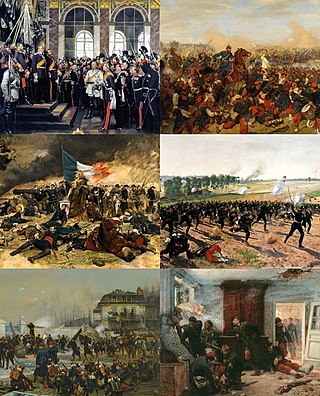
The Franco-Prussian War or Franco-German War, often referred to in France as the War of 1870, was a conflict between the Second French Empire and the North German Confederation led by the Kingdom of Prussia. Lasting from 19 July 1870 to 28 January 1871, the conflict was caused primarily by France's determination to reassert its dominant position in continental Europe, which appeared in question following the decisive Prussian victory over Austria in 1866. According to some historians, Prussian chancellor Otto von Bismarck deliberately provoked the French into declaring war on Prussia in order to induce four independent southern German states—Baden, Württemberg, Bavaria and Hesse-Darmstadt—to join the North German Confederation; other historians contend that Bismarck exploited the circumstances as they unfolded. All agree that Bismarck recognized the potential for new German alliances, given the situation as a whole.
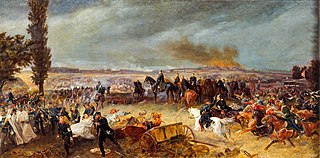
The Austro-Prussian War, also by many variant names such as Seven Weeks' War, German Civil War, Brothers War or Fraternal War, known in Germany as Deutscher Krieg, Deutscher Bruderkrieg and by a variety of other names, was fought in 1866 between the Austrian Empire and the Kingdom of Prussia, with each also being aided by various allies within the German Confederation. Prussia had also allied with the Kingdom of Italy, linking this conflict to the Third Independence War of Italian unification. The Austro-Prussian War was part of the wider rivalry between Austria and Prussia, and resulted in Prussian dominance over the German states.

Adolphe Niel was a French Army general and statesman.

Charles Denis Sauter Bourbaki was a French general.

The National Guard is a French military, gendarmerie, and police reserve force, active in its current form since 2016 but originally founded in 1789 during the French Revolution.

The Siege of Metz was a battle fought during the Franco-Prussian War from August 19 to October 27, 1870 and ended in a decisive allied German victory.

The Government of National Defense was the first government of the Third Republic of France from 4 September 1870 to 13 February 1871 during the Franco-Prussian War. It was formed after the proclamation of the Republic in Paris on 4 September, which in turn followed the surrender and capture of Emperor Napoleon III by the Prussians at the Battle of Sedan. The government, headed by General Louis Jules Trochu, was under Prussian siege in Paris. Breakouts were attempted twice, but met with disaster and rising dissatisfaction of the public. In late January the government, having further enraged the population of Paris by crushing a revolutionary uprising, surrendered to the Prussians. Two weeks later, it was replaced by the new government of Adolphe Thiers, which soon passed a variety of financial laws in an attempt to pay reparations and thus oblige the Prussians to leave France, leading to the outbreak of revolutions in French cities, and the ultimate creation of the Paris Commune.
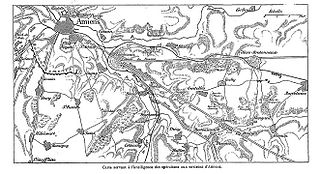
The Battle of Amiens, also known as the Battle of Villers-Bretonneux, was fought on 27 November 1870 between French and Prussian forces during the Franco-Prussian War (1870–1871). It ended in a Prussian victory, forcing the French to retreat and allowing the Prussians to capture Amiens, France.
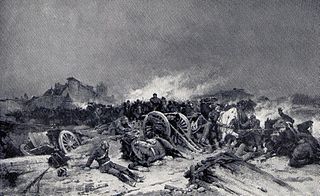
The Battle of Beaune-la-Rolande on 28 November 1870 took place during the Franco-Prussian War, which was won by Prussia. In an attempt to relieve the Siege of Paris, French General Crouzat's XX Corps launched an attack against three Prussian brigades resting in Beaune-la-Rolande. These brigades were from the Prussian X Corps which was detailed to guard the flanks and rear of the force besieging Paris and provide early warning of any French counter-attacks. The French committed a force of 60,000 men, largely conscripts of the Garde Mobile, and 140 guns against the Prussians' 9,000 men and 70 guns, mostly drawn from regular troops, although military historian Gaston Bodart estimated their strength at 40,000 men and 174 guns. Despite the superiority of numbers the French attack failed to take the village and was ultimately forced to retreat by Prussian reinforcements.

The Army of the Vosges was a volunteer force placed under the command of Giuseppe Garibaldi, formed in order to ensure the defense of the road to Lyon from the Prussian Army during the Franco-Prussian war.
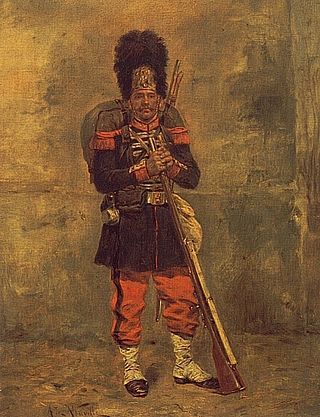
The Imperial Guard of Napoleon III was a military corps in the French Army formed by Napoleon III as a re-establishment of his uncle Napoleon I's Imperial Guard, with an updated version of the original uniforms and almost the same privileges.
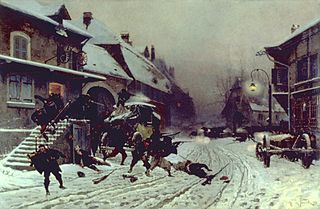
The Attack at Dawn is a painting by French painter Alphonse de Neuville, from 1877. The painting depicts a French town under siege by Prussian troops during the Franco-Prussian War.

The Battle of Saarbrücken was the first major engagement between the French Empire and the Kingdom of Prussia during the Franco-Prussian War. The battle took place on 2 August 1870, around the city of Saarbrücken.

The siege of Phalsbourg was an early battle of the Franco-Prussian War that was fought between the French Empire against Germany at Phalsbourg near the Vosges beginning on 10 August 1870, and ending on 12 December of the same year.
The Siege of La Fère took place during the Franco-Prussian War from 15 November until 26 November 1870, at the fortress of La Fère in France. French troops stationed at La Fère under the command of Captain Jacques Ferdinand Planche resisted the siege from the Imperial German Army, but surrendered the fort after eleven days on 26 November 1870, which resulted in a German victory. During the siege, the German army captured thousands of prisoners, most of whom were Garde Mobile soldiers, and took control of many French weapons. The German shelling of La Fère took place over the course of two days and severely damaged the town. After the Germans captured La Fère, they used cannons to arm the stronghold of Amiens.
The Battle of Gray, fought on 27 October 1870, was a part of the Franco-Prussian War that occurred in Haute-Saône France.
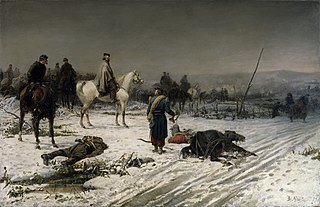
The Battles of Dijon were a series of battles that took place in 1870 and 1871, as part of the Franco-Prussian War, on the current territory of the French commune of Dijon between the French Republic and the German states of Prussia and Baden and later, the German Empire.
The Battle of Chateauneuf-en-Thimerais was a battle of the Franco-Prussian War, which took place on November 18, 1870, in the commune of Châteauneuf-en-Thymerais in France. This was one of a series of victories by a division of the Prussian army along the Loire under the command of Frederick Francis II, Grand Duke of Mecklenburg-Schwerin before the Garde Mobile's forces fledgling by commander Minister Fiereck, within a week after the Imperial German Army was defeated at the Battle of Coulmiers. During the Battle of Châteauneuf-en-Thimerais, the 22nd Division of the Kingdom of Prussia – noted as a brave division – was under the command of General Friedrich Wilhelm Ludwig von Wittich who captured the commune, taking in his hands hundreds of French prisoners of war. The failure at this battle forced the French forces to retreat westward.
The Battle of Monnaie, also known as the Battle of Tours was a battle of the Franco-Prussian War. It took place on the December 20, 1870 at Indre-et-Loire, France. During this engagement, a Hanover division of the Imperial German Army under the command of General Schwarzkoppen, belonging to Legion X under the command of Konstantin Bernhard von Voigts-Rhetz attacked and won the victory against an army of Garde Mobile's 234 led by General Ferry Pisani, driving the French to Langreais. This victory allowed the Germans to enter and occupy the city of Tours.

The siege of Rocroi was a battle of the Franco-Prussian War, it took place between 4 and 6 January 1871 at Rocroi which was a bastion of France located to the west of Sedan. After an artillery fire by the Prussian army, the officer commanding the French troops at Rocroi was forced to surrender the Division Militia under General Schuler and Sendan and Wilhelm von Woyna. With the success of the Siege of Rocroi, the military spectrum was obtained on their hands were hundreds of prisoners along with many stocks, costumes and contemporary heavyweight artillery of the French. During this siege, the town of Rocroi was heavily destroyed. The fall of Rocroi marked one of the German army's consecutive victories in the war.